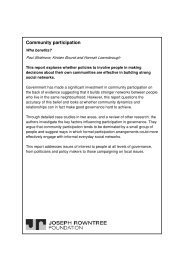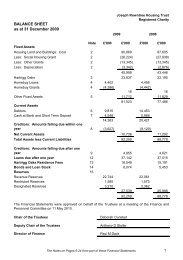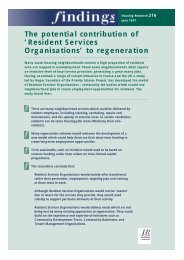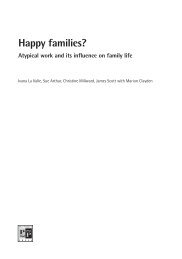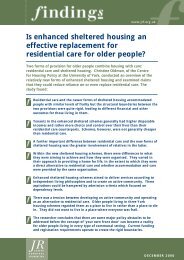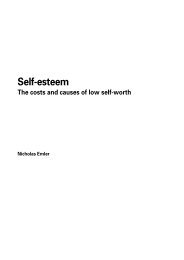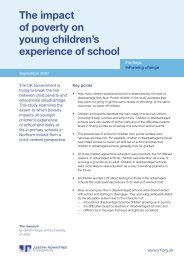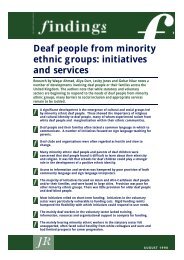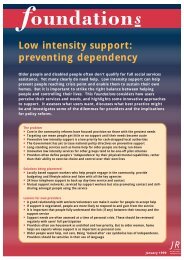Summary PDF 4 pages 0.1 MB - Joseph Rowntree Foundation
Summary PDF 4 pages 0.1 MB - Joseph Rowntree Foundation
Summary PDF 4 pages 0.1 MB - Joseph Rowntree Foundation
Create successful ePaper yourself
Turn your PDF publications into a flip-book with our unique Google optimized e-Paper software.
Background<br />
In the United Kingdom and elsewhere during the last 15<br />
years there has been growing interest in ‘social capital’<br />
as a potential source of economic and social benefits.<br />
Over the same period, both Conservative and Labour<br />
Governments in the UK have looked to faith communities<br />
as partners in a range of social policies and regeneration<br />
programmes.<br />
Social capital is seen as contributing to better educational<br />
attainment, lower crime levels, improved health, more<br />
active citizenship, better functioning labour markets and<br />
higher economic growth. It has been identified as a key<br />
consideration in the quest for sustainable neighbourhoods<br />
and the achievement of social and community cohesion.<br />
This has prompted a review of all the sources, forms<br />
and expressions of social capital and how they might be<br />
harnessed. Faith communities have featured prominently<br />
in this development of policy and practice.<br />
During the last decade, research in various regions of<br />
the UK has demonstrated the large scale and wide<br />
range of social engagement by faith organisations and<br />
groups. But it has also shown that faith communities<br />
face important internal and external obstacles to fulfilling<br />
their potential as sources and generators of social capital.<br />
Faith communities may also be obstacles to developing<br />
outward-looking and enriching social networks. Moreover,<br />
compliance with government agendas may serve to<br />
undermine the energy and distinctiveness of faith-related<br />
networks and enterprise. This research explored these<br />
issues, by means of interviews, documentary evidence<br />
and observations across a range of faiths and UK regions.<br />
Social capital and faith<br />
The idea of social capital and the place of faith in public<br />
policy and civil society are both controversial. The term<br />
‘social capital’ is sometimes distrusted because it seems<br />
to impose a utilitarian economic language on human<br />
relationships. It is also seen as linked to a community<br />
and social-order agenda which many question. Rather<br />
like the notion of ‘community’, it is also an idea which<br />
sounds positive but can hide a negative, destructive<br />
side. However, social capital is not bound inevitably to a<br />
particular economic theory or political standpoint. It is a<br />
means to expand our understanding of how people can<br />
be advantaged (or indeed disadvantaged) by their social<br />
networks as well as by their physical and human capital.<br />
In particular, the distinctions between bonding, bridging<br />
and linking social capital can be used to develop a closer,<br />
critical exploration of community networks, the resources<br />
they offer, and the constraints they impose.<br />
Recent events worldwide and within the UK have further<br />
sharpened a longstanding debate on the social impact<br />
of religion. The divisiveness of religion receives ultimate<br />
expression in violence. But faith communities can be<br />
characterised by other powerful forms of disconnection<br />
from other groups or wider society. Religious<br />
understanding that establishes a strong boundary with<br />
the rest of the world can produce passive retreat or<br />
a more active (and sometimes destructive) assertion<br />
of distinctiveness. Yet all the major faiths have core<br />
principles that can motivate bridge-building and linkmaking.<br />
In the words of just one tradition:<br />
“O mankind! Behold, we have created you from a<br />
male and a female, and have made you nations and<br />
tribes, so that you might come to know one another...”<br />
(Qur’an 49:13)<br />
All major faiths have doctrinal commitments to<br />
peace, justice, honesty, service, community, personal<br />
responsibility and forgiveness, which can contribute to the<br />
development of networks and the trusting relationships<br />
that characterise positive social capital. Recognition of<br />
these two facets of religion prompts a critical exploration<br />
of the complex field of faith and social capital.<br />
From physical capital to social capital<br />
The collective life of a faith community usually occurs<br />
within its building. For some this is an historic building,<br />
for others a newly built one or an adaptation from another<br />
type of use. Some of these places are very small. Often,<br />
however, in addition to a sacred space or worship area<br />
there are other premises, including a hall. This physical<br />
capital can be significant in developing and sustaining<br />
social capital in neighbourhoods where community<br />
buildings are scarce. Most immediately, faith buildings<br />
are a home where people can share a common life and<br />
form bonds with one another. But they can also be the<br />
means of contributing bridging and linking social capital<br />
to wider community networks. Faith buildings which are<br />
open to others offer opportunities for people to cross the<br />
boundaries of their normal circle and experience and form<br />
new social relations.<br />
“We have had faith groups coming from all<br />
communities: Sikh, Hindu, Muslim, Somalian groups,<br />
Afghan, Iranian and Kurdish ... the list is actually<br />
endless.” (Sikh development worker)<br />
JRF findings 2006



